Not a Normal Week: Doing Fun Science at Home during School Closures (Activity #9)
Follow along with a Science Buddies parent who is using family STEM activities to keep her kids learning at home during the COVID-19 school shutdown. New posts every Monday, Wednesday, and Friday. Today's adventure... building a grasping robot hand out of household materials.
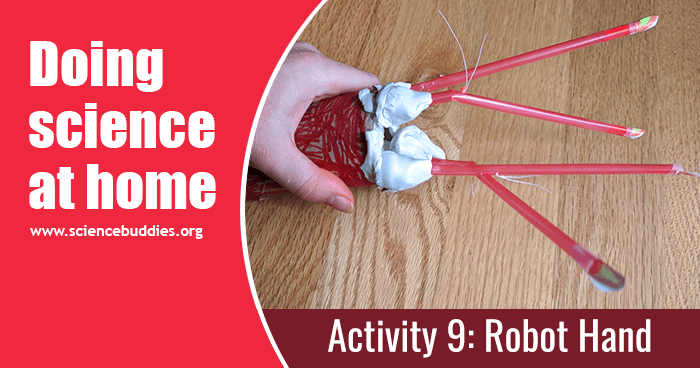
Nothing Normal Around Here
If this was a normal week, I'd be telling you all about how this is National Robotics Week (#RoboWeek), how awesome building robots is for kids of all ages, how it engages problem solving and learning about 21st century skills, etc.
All of that is true, but let's face it, this isn't a normal week. Right now, you don't care. You're just trying to get through another do-everything-from-home-without-going-insane day. Hey — I'm not even sure I care, and STEM education is both my passion and my job! We're all just trying to get through each day as best we can, and that's okay.
On the other hand, I've noticed that in these definitely-not-normal-times, my kids crave my attention. Sure, it may be because I'm literally one of three people they can talk to in person, but, regardless, they will suck up as much time as they can get with me. So why not do a robotics project together this week or some other random week?
As I see it, there are two general types of robotics projects. In category one are electronics-based activities where you build robots from kits or, if you're a DIY person who happens to have circuit components on hand, your garage. In category two are robot-themed activities that are about robots but don't use circuits. Here are a few options in each category:
Awesome Robotics Kits (if buying a kit isn't in your budget, you're in good company — skip down for no-kit options):- Bristlebot Robotics Kit : build a variety of cute, fun robots — Bristlebot, Brushbot, Junkbot, Artbot, and Vibrobots. Ideal for elementary school students of all ages.
- Advanced Bristlebots Robotics Kit: get hands-on with circuits and build two (in series) cool robots — one that follows a flashlight and one that is solar-powered. Ideal for middle school.
- BlueBot: 4-in-1 Robotics Kit: hours of fun for middle school or high school, build four (in series) robots using different sensors to drive interesting behaviors.
- Build a Robot Hand: an engineering project to assemble a robot hand that can grasp objects.
- Robot, Make Me a Sandwich!: a funny activity to understand how complicated it is to make robots do simple actions.
- Mars Rover Obstacle Course: a glimpse into what it is like to help a robot navigate unfamiliar terrain.
My Pick of the Day: Robot Hands
Having done all the Bristlebot Kit activities with my children before (I highly recommend them), I opted to try the Build a Robot Hand activity. When I told my colleague Amy of my plan, she very tactfully said she'd be curious to see how that went with my second-grader. I should probably have taken the hint.
Both kids were eager at the beginning of the activity and planned out the number of fingers and the orientation of the fingers that they wanted. My middle-schooler chose an extremely ambitious design consisting of three fingers with three joints each. My second grader opted for four single-jointed fingers. It quickly became apparent that cutting the notches out of the straws was an easy seventh-grader task and an impossible second-grader task. No problem, I notched straws for the younger one while she colored her "arm" and made highly-decorated paper fingernails for her robot.
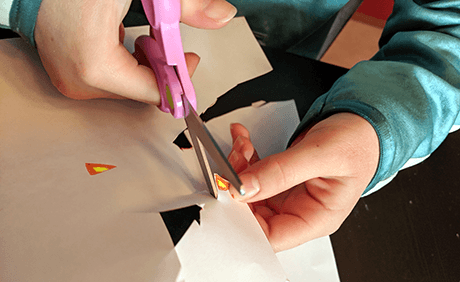
Next up was putting the string through the fingers. This admittedly took a bit of trial and error. Here's what we learned along the way:
- Once you get the needle through the plastic wall of the straw, you can gently shake the straw, and gravity will bring the needle out the other end.
- If you yank too hard, the knot in your thread will pop through the hole in the straw. Solution: a dab of glue on your knot keeps it anchored in place.
- For our straws (yours may be different) the string had to attach at least a centimeter above the notch in order for the joint to bend properly.
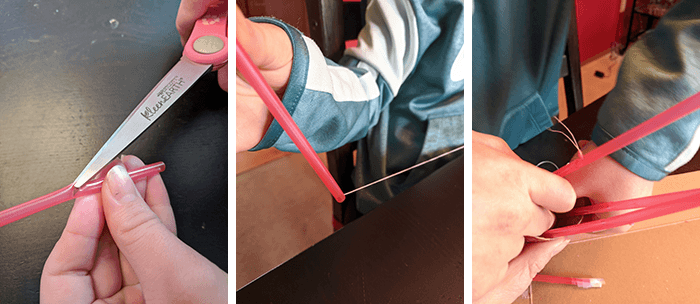
In all that trial and error, my second-grader got bored and went off to play for a bit saying, "Call me when you figure it out." My seventh-grader, on the other hand, found it interesting and stuck around to problem solve.
Once my son and I understood the basics, I called my daughter back, and she and I set up an assembly line for her robot fingers, with me doing the cutting, needle threading, and tying, and her doing the poking, shaking, and gluing. Meanwhile, my ambitious seventh-grader started battling a different set of design issues — our straws were too brittle to handle so many joints and cracked. Back to the drawing board he went.
Not finding any modeling clay in our art supplies, we grabbed our stash of playdough. That turned out to be a bad choice — it was too soft to create a palm. The straws moved every time we tugged on the strings. Then my son remembered that he had a secret stash of polymer clay left over from creating his Halloween costume, and that proved to be the perfect consistency.
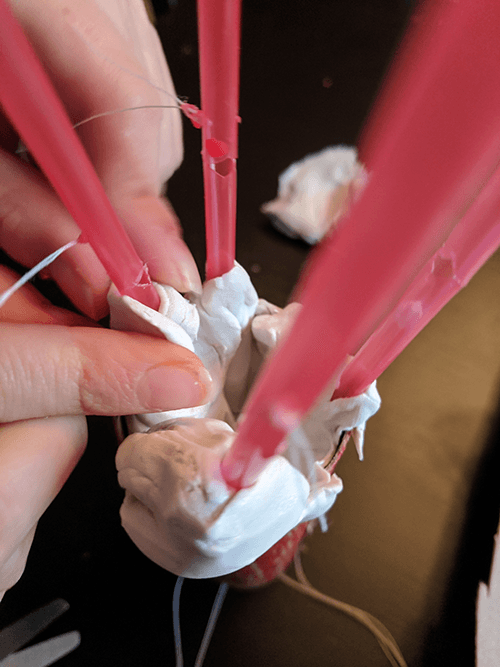
By this time, my son had abandoned his initial, very complicated vision for his robot hand, and we'd melded into one design team, with me scrambling to find tasks the second grader could successfully do. Taping on the robot's fancy fingernails was her favorite step of the process.
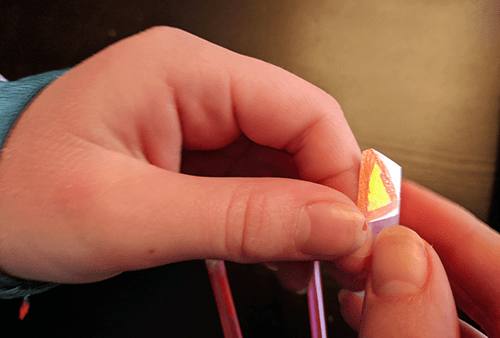
Finally we were ready to test the assembled robot hand by pulling the paper clips at the ends of the "finger" strings to make the fingers bend and see if the hand could successfully grab or pick something up. It failed at most tasks we tried. It was almost successful at grabbing a sponge. It did make a rather nice back scratcher.
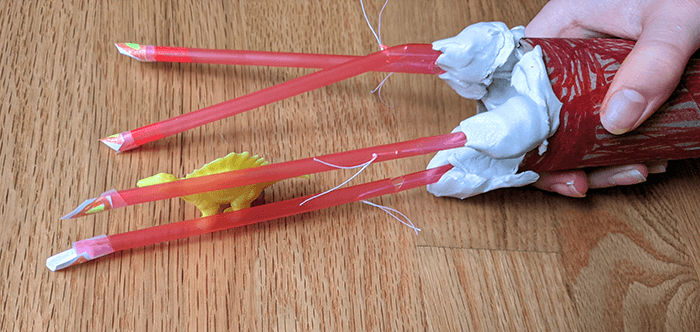
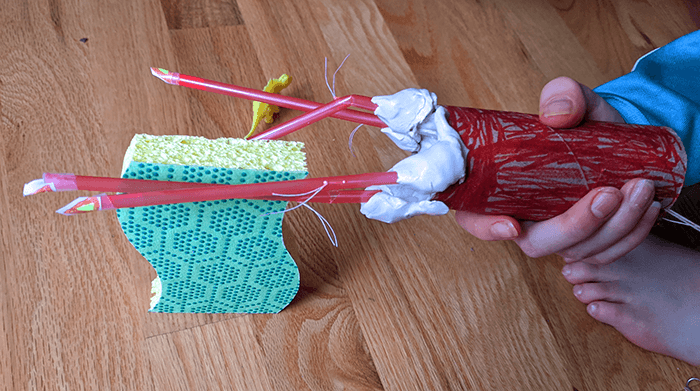
After our testing, the seventh-grader continued to fiddle with it and started remodeling the fingers a bit, but the second grader was done. I couldn't really blame her. It's a great activity for late elementary school and up, but I won't be trying it again with a second grader, even in a "normal" week.
Tip: this robotics activity uses a cardboard tube, like an empty toilet paper or paper towell roll tube. For other ideas for activities that use cardboard tubes, see 10 STEM Activities with Cardboard Tubes.
If you and your kids try engineering a robot hand or any of the other robot kits and activities, post a picture of it on social media and tag us. You can find us on Twitter, Facebook, and Instagram.
If this blog post was useful to you, please share it with other parents. Follow the links below to see what other science adventures we've been having at home.
View All Posts in this Series
- Activity 1 - Getting Started and Hand Washing
- Activity 2 - Taking Flight with Kites
- Activity 3 - Candle Seesaw and Fire Science
- Activity 4 - Dissecting Flowers
- Activity 5 - Building a Toy Parachute
- Activity 6 - Paper Marbling
- Activity 7 - Shaping Hard-boiled Eggs
- Activity 8 - Invisible Ink
- Activity 9 - Robot Hand
- Activity 10 - Plastic Egg Rockets
- Activity 11 - Rubber Band Guitar
- Activity 12 - Making Model Viruses
- Activity 13 - Air Cannons
- Activity 14 - Balancing an Art Mobile
- Activity 15 - Gumdrop Geometry
- Activity 16 - Solar Updraft Tower
- Activity 17 - Cotton Ball Launcher
- Activity 18 - Wire Water Striders
- Activity 19 - Ice Cream in a Bag
- Activity 20 - Wind-powered Sail Cars
- Activity 21 - Curling Metal
- Activity 22 - Popsicle Stick Catapult
- Activity 23 - Candy Diffusion
- Activity 24 - STEM Videos
- Activity 25 - Making Slime
- Activity 26 - Straw Siphon
- Activity 27 - Elephant Toothpaste
- Activity 28 - Balloon Hovercraft
- Activity 29 - Aluminum Foil Boats
- Activity 30 - Wall Marble Run
A science activity log is available as a Word document or as a Google doc for online convenience. (Just choose "File/Make a copy" to save it to your Google Drive.)
About the Author
Sandra, Science Buddies' Vice President of STEM education, holds a PhD in Genetics from Stanford University and has spent the last twelve years working on science education and STEM outreach. Right now, she's stuck working from her home in the Pacific Northwest with her husband, second grader, middle schooler, and two oddly noisy gerbils. She hypothesizes her sanity will hold as long as she gets a daily dose of sunshine.
Categories:
You Might Also Enjoy These Related Posts:
- Wall Marble Run: Doing Fun Science at Home during School Closures (Activity #30)
- Aluminum Foil Boats: Doing Fun Science at Home during School Closures (Activity #29)
- Hovercraft: Doing Fun Science at Home during School Closures (Activity #28)
- Elephant Toothpaste: Doing Fun Science at Home during School Closures (Activity #27)
- Straw Siphon: Doing Fun Science at Home during School Closures (Activity #26)
- Slime Three Ways: Doing Fun Science at Home during School Closures (Activity #25)
- A STEM Videos Breather: Doing Fun Science at Home during School Closures (Activity #24)
- Candy Experiments: Doing Fun Science at Home during School Closures (Activity #23)









